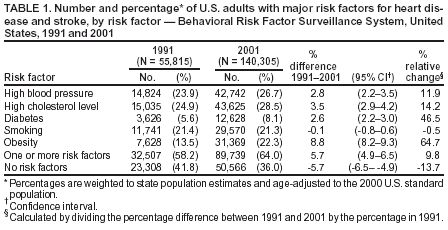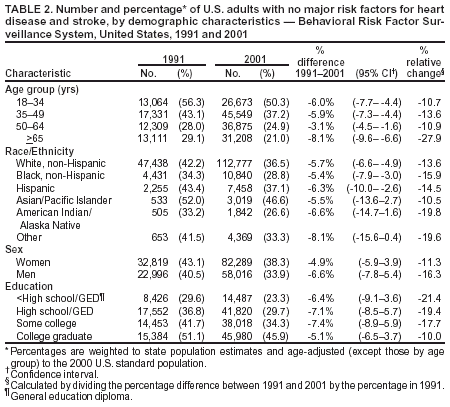 |
|
|
|
|
|
|
| ||||||||||
|
|
|
|
|
|
|
||||
| ||||||||||
|
|
|
|
|
Persons using assistive technology might not be able to fully access information in this file. For assistance, please send e-mail to: mmwrq@cdc.gov. Type 508 Accommodation and the title of the report in the subject line of e-mail. Declining Prevalence of No Known Major Risk Factors for Heart Disease and Stroke Among Adults --- United States, 1991--2001Despite declines in recent years, heart disease and stroke remain the first and third leading causes of death in the United States, respectively. Of all U.S. deaths in 2001, heart disease accounted for 29.0% and stroke for 6.8% (1). The major risk factors for both conditions are high blood pressure, high cholesterol, diabetes, smoking, and obesity, all of which have been targeted by national prevention programs. In addition, the prevalence of multiple major risk factors has been a matter of increasing concern. However, few studies of national and state-level data have examined the prevalence of no known major risk factors among adults and how that prevalence has changed during the preceding 10 years (2). To assess changes in prevalence of no known risk factors for heart disease and stroke during 1991--2001, CDC analyzed data from the Behavioral Risk Factor Surveillance System (BRFSS). This report summarizes the results of that analysis, which indicate that prevalence of no known major risk factors is decreasing among men and women in nearly all states, racial/ethnic populations, age groups, and education levels. In addition, the prevalence of individual major risk factors is increasing. These findings underscore the potential for an increased burden of heart disease and stroke on the health-care system. To prevent the debilitating outcomes of heart disease and stroke among the aging U.S. population, increased prevention efforts and treatment interventions are needed. BRFSS is a state-based, random-digit--dialed telephone survey of the noninstitutionalized, U.S. civilian population aged >18 years. Data for this analysis are from the core surveys conducted during 1991 and 2001 in 47 states and the District of Columbia (DC). Median response rates were 70.8% (range: 37.7% [Florida]--83.7% [North Dakota]) in 1991 and 51.1% (range: 33.3% [New Jersey]--70.8% [Hawaii and Montana]) in 2001. Respondents were asked whether they had ever had their blood cholesterol checked and, if so, whether they had been told by a health-care professional that their blood cholesterol was high. Respondents also were asked whether they had ever been told by a health-care professional that they had diabetes or been told by a health-care professional that they had high blood pressure. Respondents were classified as smokers if they had smoked >100 cigarettes in their lifetime and currently smoked every day or some days. Self-reported data on height and weight were used to calculate body mass index (BMI). Obesity was defined as a BMI >30 kg/m2. Data were weighted to account for age, race/ethnicity, sex distribution, and rate of nonresponse in each state. Analyses were conducted by using SUDAAN to account for the complex sampling design and to calculate variance estimates. Differences in percentages were assessed by chi square, with a significant difference determined as p<0.05. The results were age-adjusted to the U.S. 2000 standard population to allow for comparisons over time and among states. During 1991--2001, the prevalence of reported high blood pressure, high cholesterol, diabetes, and obesity among U.S. adults increased, whereas the prevalence of smoking remained nearly the same (Table 1). The prevalence of no known risk factors was lower in 2001 than in 1991 for men and women of all ages, racial/ethnic populations, and education levels (Table 2). The lower prevalence was statistically significant for all racial/ethnic populations except Asians/Pacific Islanders and American Indians/Alaska Natives, whose sample sizes in 1991 were too small for meaningful analysis. Men had a greater decline in prevalence of no known risk factors than women (6.6% versus 4.9%). The age-standardized prevalence of having no risk factors decreased from 42% in 1991 to 36% in 2001. This decrease occurred in all geographical areas (range: 0.8% [Wisconsin]--12.5% [New Mexico]) except Hawaii, where prevalence increased 0.4% (Table 3). These decreases were statistically significant in 35 states and DC and not significant in 11 states (Table 3). Reported by: N Paynter, MPH, CH Denny, PhD, KJ Greenlund, PhD, JB Croft, PhD, GA Mensah, MD, Div of Adult and Community Health, National Center for Chronic Disease Prevention and Health Promotion, CDC. Editorial Note:During 1991--2001, the prevalence of no known major risk factors for heart disease and stroke declined, suggesting that a decreased percentage of U.S. adults have no recognized risk factors for heart disease and stroke. As a result, the national burden of heart disease and stroke is expected to increase. The findings in this report are subject to at least three limitations. First, BRFSS data are based on self-reports and are subject to recall and social desirability biases. Second, increases in certain self-reported risk factors might be attributed to increased screening. Although increased screening might account for higher prevalence of high cholesterol, it probably does not account for increases in high blood pressure and diabetes; national examination surveys observed the same trends, and such trends are expected with the increase in obesity (3,4). Finally, whether the lower response rate in 2001 might have influenced the results is unknown. Prevalence of risk factors in 2001 might be overestimated if healthier persons were less likely to respond to telephone surveys. However, the trends observed in the telephone surveys also have been reported for the U.S. population that participated in national examination surveys during a similar study period (3,4). CDC, in collaboration with its partners, supports prevention programs to increase awareness and reduce the burden of high blood pressure, high blood cholesterol, smoking, diabetes, and obesity. National guidelines provide information on detecting, treating, and controlling these risk factors (5--9). Physicians are encouraged to seek opportunities in the clinical setting to prevent, detect, and treat these conditions. The prevention of risk factors for heart disease and stroke should remain a national public health priority. References
Table 1  Return to top. Table 2  Return to top. Table 3  Return to top.
Disclaimer All MMWR HTML versions of articles are electronic conversions from ASCII text into HTML. This conversion may have resulted in character translation or format errors in the HTML version. Users should not rely on this HTML document, but are referred to the electronic PDF version and/or the original MMWR paper copy for the official text, figures, and tables. An original paper copy of this issue can be obtained from the Superintendent of Documents, U.S. Government Printing Office (GPO), Washington, DC 20402-9371; telephone: (202) 512-1800. Contact GPO for current prices. **Questions or messages regarding errors in formatting should be addressed to mmwrq@cdc.gov.Page converted: 1/15/2004 |
|||||||||
This page last reviewed 1/15/2004
|